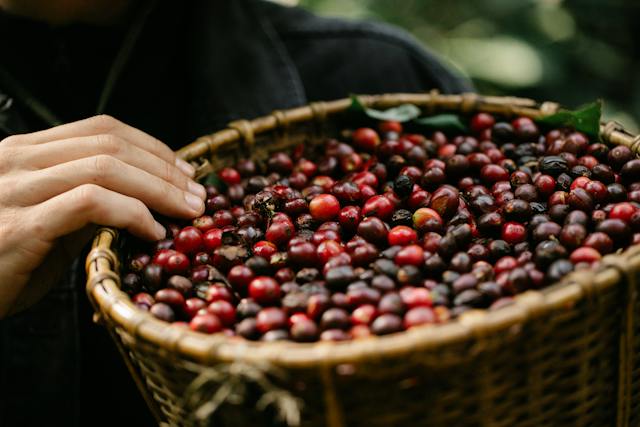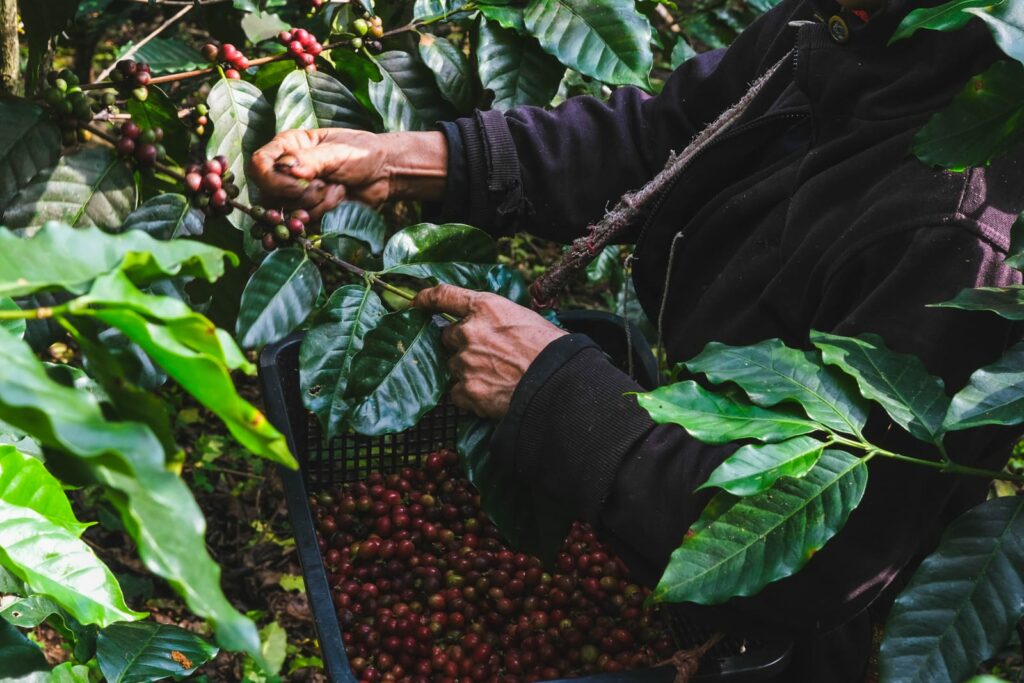The story of Kona Typica Coffee is one steeped in tradition and dedication. For over a century, generations of passionate farmers have cultivated the unique Arabica coffee beans, ensuring each cup brims with the true essence of Hawaiian hospitality. From the moment the seeds are carefully nurtured and the cherries are hand-picked under the golden sun, to the meticulous roasting process that releases intoxicating aromas, every step is a testament to the craft that goes into creating this liquid gold.
History of Kona Coffee Beans in Hawaii

How did Kona coffee originate in Hawaii?
Kona Coffee’s journey began in the early 19th century when an American missionary named Reverend Samuel Ruggles arrived in the Kona region of the Big Island of Hawaii. In 1828, Reverend Ruggles brought a single coffee plant from Brazil, kickstarting what would soon become an enduring legacy. Planted in the fertile volcanic soil and blessed by the island’s idyllic climate, Kona Coffee found a new home where it would flourish like nowhere else.
What is the significance of Kona coffee in Hawaii’s history?
For over a century, Kona coffee has been deeply ingrained in the cultural fabric of Hawaii. It has become a symbol of Hawaiian craftsmanship, representing the dedication and passion of local farmers. Its cultivation and production have not only shaped the island’s landscape but also played a vital role in its economy.
With each sip, Kona coffee carries the essence of the region’s history, reflecting the harmony between nature and human ingenuity. As time passed, this aromatic beverage became an iconic ambassador of Hawaiian hospitality, celebrated both locally and globally for its unparalleled quality and flavor.
Who introduced coffee beans to the Kona zone?
Reverend Ruggles is credited with introducing coffee beans to the Kona zone. Inspired by the potential of the land and its unique volcanic soil, he carefully planted that first coffee plant grown in Kona, nurturing it with love and dedication. From there, the seeds of Kona coffee spread across the slopes of Mauna Loa, finding their place among the lush greenery and becoming an integral part of the Kona community.
Cultivation and Characteristics
Kona coffee’s distinctive taste can be attributed to its cultivation process and the favorable growing conditions in the region. The volcanic soil, rich in minerals, imparts a unique flavor profile, while the gentle trade winds and ample rainfall create the perfect microclimate for the coffee plants to thrive.
Unlike mass-produced coffees, Kona coffee is meticulously hand-picked, ensuring that only the ripest cherries are harvested. This attention to detail contributes to the exceptional quality that sets Kona coffee apart. After harvesting, the beans undergo a carefully monitored roasting process, allowing their flavors to develop fully, resulting in a smooth and balanced cup of coffee.
Kona Coffee vs. Other Varieties
One might wonder about the distinctions between Kona and other varieties of coffee in the world. While each coffee-growing region has its unique character, Kona coffee stands out for its exceptional smoothness and exquisite balance of flavors. Its medium body is complemented by notes of caramel, chocolate, and a hint of tropical fruit, creating a sensory experience that is truly unmatched.
The Impact on the Local Economy
Kona coffee has not only left an indelible mark on Hawaiian culture but also plays a vital role in the local economy. The industry supports numerous small-scale coffee farms, providing employment opportunities and contributing to the sustainable development of the region. Through its global recognition and demand, Kona coffee has become a source of pride for the community, showcasing the craftsmanship and dedication of Hawaiian farmers.
The Kona Hawaiian Coffee Industry

How Big is the Coffee Industry in Kona?
The coffee sector in Kona, Hawaii, boasts a rich history and continues to thrive as a significant player in the global coffee market. Dating back to 1825 when 30 arabica plants were brought from Brazil, the industry has grown exponentially, establishing its reputation for exquisite quality and flavor.
The production of Kona coffee primarily occurs between August and December, with an estimated 7,800 acres of coffee trees planted across the Hawaiian islands. The Big Island, home to the renowned Kona area, accounts for a considerable portion of this cultivation. In the 2015-2016 season, the bearing acreage reached 6,900, producing an impressive 31,740,000 pounds of delicious Kona coffee.
Kona coffee is highly regarded both locally and globally, contributing significantly to Hawaii’s economy. With an annual production value exceeding $48 million, it holds the distinction of being the second most valuable commodity produced in the state. Its popularity and the demand for coffee continue to grow, reflecting the enduring allure of this exceptional Hawaiian brew.
What Makes Kona Coffee So Special?
Kona coffee’s exceptional quality stems from several unique factors that set it apart from other coffee species. The region’s volcanic soil, enriched with minerals, lends distinctive characteristics to the beans. Coupled with favorable growing conditions, including gentle trade winds, ample rainfall, and an ideal elevation range of 500 to 2,500 feet, Kona Coffee achieves a remarkable balance of flavors.
The carefully hand-picked coffee cherries undergo meticulous processing and roasting to bring out the beans’ full potential. This attention to detail accentuates Kona coffee’s signature medium body, complemented by delightful notes of caramel, chocolate, and a hint of tropical fruit. Each sip presents a sensory experience that embodies the harmony between nature and craftsmanship.
Who Are the Main Players in the KonaCoffee Industry?
The Kona coffee industry thrives due to the collective efforts of dedicated farmers, processors, and distributors who uphold the tradition of excellence. These individuals pour their passion, expertise, and love for the land into every step of the coffee production process.
- Farmers: At the heart of the industry are the farmers who meticulously tend to the coffee trees, nurturing them to perfection. Their commitment to sustainable farming practices and meticulous harvesting ensures the highest quality beans.
- Processors: Once the cherries are harvested, processors carefully remove the outer layers to reveal the beans within. This crucial stage requires expertise, as improper processing can affect the final flavor. Dedicated processors bring out the unique characteristics of Kona coffee through their skillful handling.
- Distributors: The distribution network plays a vital role in connecting Kona coffee with consumers worldwide. By working closely with farmers and processors, distributors ensure that the exceptional flavors of Kona coffee reach markets across the globe.
These key players work hand in hand, fostering a sense of community and collaboration that further enhances the reputation of Kona Coffee. Their unwavering dedication to quality and their connection to the land contribute to the ongoing success of the Kona coffee sector.
Coffee Farming in Kona

Nestled along the stunning western coast of Hawaii’s Big Island, the vibrant region of Kona offers not only breathtaking landscapes but also a thriving coffee industry. Known for its unique flavor profile and exceptional quality, Kona coffee has gained international recognition, making it a must-try for coffee enthusiasts around the world.
How do farmers in Kona grow coffee?
Farmers in Kona employ unique techniques and practices to cultivate their coffee bushes in their coffee plantations and ensure optimal growth and flavor development. Here are some key aspects of coffee farming in Kona:
- Varieties and Planting: Kona coffee predominantly consists of Arabica varietals, such as Typica, Red Caturra, and Yellow Caturra. Farmers carefully select and plant these varietals, considering factors like elevation, soil conditions, and microclimates to enhance the coffee’s flavor potential.
- Shade-Grown Coffee: Many Kona coffee farms embrace shade-grown practices, where coffee seedlings and bushes are cultivated under the canopy of taller trees. This method protects the delicate coffee plants from excessive sunlight, encourages slower ripening, and enhances the development of complex flavors in the coffee cherries.
- Hand-Picking: Harvesting Kona coffee cherries is a labor-intensive process that involves meticulous hand-picking of only the ripest cherries. This selective harvesting ensures the highest quality beans, as only fully mature cherries are collected.
Challenges Faced by Kona Farmers and Solutions:
While Kona’s coffee sector thrives, it faces its fair share of challenges. These include pests like the coffee berry borer, volatile weather conditions, and increased competition. However, Kona farmers have developed innovative strategies to overcome these obstacles. Integrated pest management techniques, climate-resilient farming practices, and collaboration among farmers have helped mitigate these challenges and maintain the exceptional quality that Kona coffee is known for.
The Journey from Farm to Cup:
The production process of Kona coffee involves several meticulous steps that contribute to its exceptional flavor and aroma:
- Bean Picking: Once the coffee cherries reach their optimal ripeness, skilled pickers harvest them by hand, selecting only the finest cherries.
- Processing: Coffee cherries undergo two primary processing methods: the wet method and the dry method. The wet method involves removing the fruit pulp and fermenting the beans, while the dry method involves sun-drying the cherries before extracting the beans.
- Milling: After processing, the beans go through milling, which removes the final layers of dried fruit, leaving behind the green beans.
- Roasting: Green coffee beans are carefully roasted to unlock their full flavor potential. Roasters employ different roasting profiles to achieve the desired taste and aroma characteristics, ranging from light to dark roasts.
- Packaging and Distribution: Once roasted, the beans are packaged with care to preserve their freshness and flavor. Kona coffee is then distributed to local markets, specialty coffee shops, and even exported worldwide, allowing coffee enthusiasts to savor the unique taste of Kona.
Kona Coffee and its Unique Characteristics

Kona coffee, a treasure from the volcanic slopes of Hawaii’s Island, has captivated coffee connoisseurs worldwide with its exquisite flavor and exceptional quality.
What is Kona Coffee and How is it Grown?
Kona coffee refers to the beans that are grown in the Kona coffee belt, a small region on the western coast of the Island of Hawaii. This area boasts the perfect combination of fertile volcanic soil, ideal climatic conditions, and high altitude, providing the optimal environment for coffee cultivation.
Kona Coffee’s Distinctive Characteristics: Kona coffee stands apart from other types of coffee due to its exceptional characteristics that are a result of its unique coffee growing conditions and meticulous farming practices. Let’s explore what sets Kona Coffee apart:
- Flavor Profile: Kona coffee is renowned for its smooth, well-balanced flavor profile, characterized by hints of chocolate, nuts, and floral notes. It offers a vibrant acidity and a mild, pleasant aftertaste, making it a delight to savor.
- Aroma: The aroma of Kona coffee is rich, with enticing notes of tropical fruits, caramel, and spices. The fragrance that emanates from a freshly brewed cup of Kona coffee is captivating and invites you to indulge in its sensory pleasures.
- Mild Acidity: Kona coffee is known for its gentle acidity, which lends a pleasant brightness to the cup without overpowering the subtle flavors. This balanced acidity makes Kona coffee enjoyable for those with sensitive stomachs or those who prefer a milder coffee experience.
The Kona Coffee Belt:
The coffee belt in Kona encompasses approximately 30 miles along the western coast of the Island, stretching from the slopes of Hualalai Volcano to Mauna Loa Volcano. This region’s specific geographical features contribute significantly to the unique characteristics of Kona coffee:
- Climatic Conditions: The climate in the region is influenced by the warm ocean breezes and the shelter provided by the volcanic mountains. The area experiences a microclimate with moderate temperatures, abundant rainfall, and ample sunlight, creating an ideal environment for coffee cultivation.
- Altitude: The altitude at which Kona coffee is grown plays a crucial role in its flavor development. The coffee farms in the region are situated between 500 and 3,000 feet above sea level. This elevation, combined with the volcanic soil, helps to create the distinct flavor profile that Kona coffee is celebrated for.
Why is Kona Coffee Considered a Specialty Coffee?
Kona Coffee has earned its reputation as a specialty coffee due to the meticulous processes involved in its production and the exceptional care taken by Kona coffee farmers. Here are some reasons why Kona coffee stands out:
- Selective Harvesting: Kona coffee cherries are hand-picked, ensuring that only the ripest, highest-quality cherries are selected. This selective harvesting contributes to the coffee’s superior flavor and ensures consistency in taste.
- Processing Methods: Kona coffee cherries undergo careful processing, with options such as the wet method or the dry method. These methods allow for optimal flavor extraction and provide the foundation for the coffee’s distinctive characteristics.
- Roasting Expertise: Kona beans are expertly roasted to bring out their unique flavors. Roasters use their knowledge and expertise to craft the perfect roast profiles, resulting in a flavorful and aromatic cup of coffee.
- Quality Control: The Kona Coffee Council and other regulatory bodies enforce strict quality control measures to maintain the integrity and authenticity of Kona coffee. This ensures that consumers can trust they are getting genuine Kona coffee with every sip.
How did Kona Coffee begin?
Kona coffee history dates back to the early 19th century when Reverend Samuel Ruggles brought the first coffee bush to the Kona District. He planted the first coffee crop on the Kona Coffee Belt, and from there, the coffee sector in the region started to flourish.
What makes Kona Coffee so special?
Kona Coffee is considered special due to its ideal growing conditions in the Kona area. The combination of volcanic soil, mild climate, and elevation creates a unique environment for the coffee plants to thrive, resulting in rich and flavorful beans.
Who are the coffee farmers in Kona?
Kona Coffee is primarily grown by dedicated coffee farmers in the Kona region of Hawaii. These farmers meticulously care for their coffee trees, ensuring the highest quality beans are harvested, processed, and roasted.
How is Kona Coffee produced?
Kona Coffee production involves several steps. After the coffee cherries are harvested, the outer fruit is removed, revealing the beans. These beans are then dried, milled, roasted, and finally, brewed to create the delicious Kona Coffee we enjoy.
Can Kona Coffee be blended with other coffee varieties?
Yes, Kona Coffee can be blended with other coffee varieties. A popular blend is the Kona Blend, which combines Kona beans with beans from other regions. However, for a coffee to be labeled as “Kona Coffee,” it must contain a minimum of 10% Kona beans.




